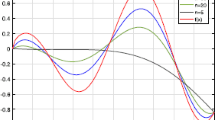Abstract
The current article deals with the study of Baskakov–Szász–Mirakyan operators which reproduces constant and exponential functions. We discuss a uniform estimate and establish a quantitative result for the modified operators.
Similar content being viewed by others
1 Baskakov–Szász–Mirakyan operators
In [7] was introduced the Baskakov–Szász–Mirakyan operators as follows:
where
and \((n)_0=1\), \((n)_k=n(n+1)\cdots (n+k-1)\) for \(k\ge 1\). Some approximation properties of these operators and their different versions have been discussed in [9, 10]. Recently, Acar et al. [1] introduced a modified form of the Szász–Mirakyan operator that reproduces the functions 1 and \(e^{2ax}, a>0\) fixed. This study was continued by Gupta and Aral [11], where they discussed a Kantorovich type modification of Szász–Mirakyan operators, preserving \(e^{-x}\) and constant functions. A modification of the Phillips operators, which reproduces the exponential function along with constant function, was also studied in [12]. So, using the technique proposed in [1, 11, 12], we modify the operators defined in (1) as follows:
In case \(a_n(x)=b_n(x)=x\), we get the operators due to Agrawal and Mohammad [7]. Suppose that operators (2) reproduce \(e^{ax}\) and \(e^{bx}\). After simple computation, we get
Thus, using (3) and the well known binomial series \(\sum _{k=0}^{\infty } \frac{(a)_k}{k!}z^k=(1-z)^{-a},|z|<1,\) we have
Similarly
These imply
and
Our study is given for \(a=0, b=-1\) and \(a=0, b=-2\). In these two cases our operator (2) is positive and preserves the exponential functions \(e^{ax}\) and \(e^{bx}\), respectively.
2 Lemmas
Lemma 1
For \(\theta \in \mathbb {R}\), we have
where \(a_n(x)\) and \(b_n(x)\) are used from (4) to (5).
Lemma 2
For \(\mu ^G_{n,r}(x)=G_n(t^r,x)\) moments may be obtained as
-
(i)
\(\mu ^G_{n,0}(x) =1\),
-
(ii)
\(\mu ^G_{n,1}(x) = b_n(x)\),
-
(iii)
\(\mu ^G_{n,2}(x)= \displaystyle \frac{1}{n} b_n(x)(b_n(x)n+b_n(x)+2)\),
-
(iv)
\(\mu ^G_{n,3}(x) =\displaystyle \frac{1}{n^2}b_n(x) \left\{ b_n^2(x)n^2+3b_n^2(x)n+2b_n^2(x)+6b_n(x)n+6b_n(x)+6\right\} \),
-
(v)
\(\mu ^G_{n,4}(x) =\displaystyle \frac{1}{n^3}b_n(x)\left\{ b_n^3(x)n^3+6b_n^3(x)n^2+11b_n^3(x)n+12b_n^2(x)n^2+6b_n^3(x)\right. \left. \qquad \qquad \qquad +\,36b_n^2(x)n +24b_n^2(x)+36b_n(x)n+36b_n(x)+24\right\} .\)
Lemma 3
Let \(T^G_{n,r}(x):=G_n((t-x)^r,x)\) be the central moments of the operators (2). Then, we have
-
(i)
\( T^G_{n,0}(x) = 1\),
-
(ii)
\(T^G_{n,1}(x) =(b_n(x)-x)\),
-
(iii)
\(T^G_{n,2}(x)= \displaystyle \frac{1}{n}\left\{ b_n^2(x)n-2b_n(x)nx+nx^2+b_n^2(x)+2b_n(x)\right\} \).
Also, it follows
3 Main results
We consider by \(C^*[0,\infty )\) the class of real-valued continuous functions f(x), possessing finite limit for x sufficiently large and equipped with the uniform norm. Uniform convergence of certain sequence of positive linear operators was considered in [8]. About four decades later Holhoş [13] considered this problem and obtained the following quantitative estimate for a sequence \(L_n,\) of positive linear operators:
Denote \(\varphi _i(x)=e^{-ix}\), \(x\in [0,\infty )\), \(i=0,1,2\).
Theorem A
[13] For a sequence of positive linear operators \(L_n: C^*[0,\infty )\rightarrow C^*[0,\infty )\), if for \(i=0,1,2\) we denote the norms \(|| L_n(e^{-it})-\varphi _i||_{[0,\infty )}\) as \(\alpha _n, \beta _n\) and \(\gamma _n\) respectively, and \(\alpha _n,\beta _n,\gamma _n\) tend to 0 as \(n\rightarrow \infty \), then
where the modulus of continuity is given by
Theorem 1
For \(f\in C^*[0,\infty ),\) we have
-
(i)
If \(a=0, b=-1\), then
$$\begin{aligned} || G_nf-f||_{[0,\infty )}\le 2\omega ^*\left( f,\sqrt{\gamma _n}\right) , \end{aligned}$$(6)where
$$\begin{aligned} \gamma _n= & {} || G_n(e^{-2t})-\varphi _2||_{[0,\infty )} \rightarrow 0, n\rightarrow \infty . \end{aligned}$$ -
(ii)
If \(a=0, b=-2\), then
$$\begin{aligned} || G_nf-f||_{[0,\infty )}\le 2\omega ^*\left( f,\sqrt{2\beta _n}\right) , \end{aligned}$$(7)where
$$\begin{aligned} \beta _n= & {} || G_n(e^{-t})-\varphi _1||_{[0,\infty )} \rightarrow 0, n\rightarrow \infty . \end{aligned}$$
Proof
(i) For \(a=0, b=-1\), by Lemma 1, the operators \(G_n\) satisfy
which preserve \(e^{-x}\) and constants, so \(\alpha _n=\beta _n=0\). We only have to evaluate \(\gamma _n\). By simple calculations we obtain:
Using the software Maple, we get
Since,
we obtain
Using Theorem A, the proof of (i) is completed.
(ii) For \(a=0, b=-2\), by Lemma 1, the operators \(G_n\) satisfy
which preserve \(e^{-2x}\) along with constant functions, so \(\alpha _n=\gamma _n=0\). We only have to evaluate \(\beta _n\).
By simple calculations we obtain:
Making use of the software Maple, we immediately have
Using the identities
we have
Using Theorem A, the proof of (ii) is completed. \(\square \)
Example 1
Let \(a=0,b=-1\). The convergence behaviour of the operators \(G_n(f,x)\) is illustrated in Fig. 1, where \(f(x)=x^3e^{-3x}\), \(x\in [0,7]\) and \(n\in \{10,20,30\}\). We can see that for the values of n increasing, the graph of the operator \(G_n(f,x)\) goes to the graph of the function f.
Example 2
Let \(a=0, b=-2\). The convergence behaviour of \(G_n(f,x)\) is illustrated in the Fig. 2, where \(f(x)=2x^4-3x^2+6\), \(x\in [0,2]\) and \(n\in \{50,100,500\}\). We can see that for the values of n increasing, the graph of \(G_n(f,x)\) goes to the graph of the function f.
Lemma 4
The Szász–Mirakyan–Kantorovich operators defined in (1) verify the identities:
-
(i)
\( B_n(e^{-t},x)=\left( \displaystyle \frac{n+x+1}{n+1} \right) ^{-n} =e^{-x}+\displaystyle \frac{e^{-x}}{n}\left( \frac{x^2}{2}+x\right) +{\mathcal O}\left( \frac{1}{n^2}\right) \),
-
(ii)
\(B_n(e^{-2t},x)=\left( \displaystyle \frac{n+2x+2}{n+2} \right) ^{-n}=e^{-2x}+\displaystyle \frac{e^{-2x}}{n}(2x^2+4x)+{\mathcal O}\left( \frac{1}{n^2}\right) \).
Remark 1
For \(f\in C^*[0,\infty )\),the original Baskakov–Szász–Mirakyan operators verify:
where
Since \(\gamma _n\le \tilde{\gamma }_n\) and \(\beta _n\le \tilde{\beta }_n\), from the relations (6), (7), (8) it follows the better approximation for the modified Baskakov–Szász–Mirakyan operators \(G_n\) than the usual Baskakov–Szász–Mirakyan operators \(B_n\).
Example 3
Let \(f(x)=-2x^2e^{-3x}\), \(n=20\), \(x\in [0,5]\). For \(a=0,b=-1\), respectively \(a=0,b=-2\), the approximation to the function f by the modified operator \(G_{n}\), and the classical ones is illustrated in the Fig. 3. We note that in this case the modified operators \(G_{n}\) presents an order of approximation better than the operator \(B_n\). In Table 1 we have computed the error of approximation for these operators at some points.
In the next result, we present a quantitative form of Voronovskaya formula. Nowadays such a result has been studied for many operators and for many moduli of continuity in classical and weighted cases (see [2,3,4,5,6, 14]).
Theorem 2
Let \(f,f^{\prime \prime }\in C^*[0,\infty )\), then for any \(x\in [0,\infty )\), we have
where
Proof
By Taylor’s expansion, we have
where
and \(\eta \) is a number lying between x and t. If we apply the operator \(G_n\) to both sides of (9), we have
Applying Lemma 3, we get
To complete the proof of the theorem, it remains to estimate the term \(|nG_n(h(t,x)(t-x)^2,x)|\). Applying the methods used in [1], we can write
Obviously using this and Cauchy–Schwarz inequality and choosing \(\delta =n^{-1/2}\), we get
where
Thus the proof of theorem is complete. \(\square \)
Remark 2
By direct calculations can be obtained the following results
-
(i)
\(\displaystyle \lim _{n\rightarrow \infty }n^2 T_{n,4}^{G}(x)=3x^2(x+2)^2,\)
-
(ii)
\(\displaystyle \lim _{n\rightarrow \infty } n^2 G_n\left( \left( e^{-x}-e^{-t}\right) ^4,x\right) =3x^2(x+2)^2e^{-4x}.\)
As a consequence of the Theorem 2 and Remark 2 can be obtained the following result:
Corollary 1
Let \(f,f^{\prime \prime }\in C^*[0,\infty )\), then for \(x\in [0,\infty )\) we have
References
Acar, T., Aral, A., Gonska, H.: On Szász–Mirakyan operators preserving \(e^{2ax}\), a>0. Mediterr. J. Math. 14(1), 6 (2017)
Acar, T.: Asymptotic formulas for generalized Szász–Mirakyan operators. Appl. Math. Comput. 263, 233–239 (2015)
Acar, T., Ulusoy, G.: Approximation by modified Szász–Durrmeyer operators. Period. Math. Hung. 72(1), 64–75 (2016)
Acar, T., Aral, A., Rasa, I.: The new forms of Voronovskayas theorem in weighted spaces. Positivity 20(1), 25–40 (2016)
Acar, T.: Quantitative q-Voronovskaya and q-Grüss–Voronovskaya-type results for q-Szász operators. Georgian Math. J. 23(4), 459–468 (2016)
Acar, T., Aral, A., Cárdenas-Morales, D., Garrancho, P.: Szász–Mirakyan type operators which fix exponentials. Results Math. 72(3), 1393–1400 (2017)
Agrawal, P.N., Mohammad, A.J.: Linear combination of a new sequence of linear positive operators. Rev. Union Mat. Argent. 44(1), 33–41 (2003)
Boyanov, B.D., Veselinov, V.M.: A note on the approximation of functions in an infinite interval by linear positive operators. Bull. Math. Soc. Sci. Math. Roum. 14(62), 9–13 (1970)
Gupta, V.: Approximation by Generalizations of Hybrid Baskakov Type Operators Preserving Exponential Functions, Mathematical Analysis and Applications: Selected Topics. Wiley, Hoboken (2017)
Gupta, V., Agarwal, R.P.: Convergence Estimates in Approximation Theory. Springer, Berlin (2014)
Gupta, V., Aral, A.: A note on Szász–Mirakyan–Kantorovich type operators preserving \(e^{-x}\). Positivity (2017). https://doi.org/10.1007/s11117-017-0518-5
Gupta, V., Tachev, G.: On approximation properties of Phillips operators preserving exponential functions. Mediterr. J. Math. 14(4), 177 (2017)
Holhoş, A.: The rate of approximation of functions in an infinite interval by positive linear operators. Stud. Univ. Babe-Bolyai Math. 2, 133–142 (2010)
Ulusoy, G., Acar, T.: q-Voronovskaya type theorems for q-Baskakov operators. Math. Methods Appl. Sci. 39(12), 3391–3401 (2016)
Acknowledgements
The research work of the second author is supported from Lucian Blaga University of Sibiu research Grants LBUS-IRG-2017-03.
Author information
Authors and Affiliations
Corresponding author
Rights and permissions
About this article
Cite this article
Gupta, V., Acu, A.M. On Baskakov–Szász–Mirakyan-type operators preserving exponential type functions. Positivity 22, 919–929 (2018). https://doi.org/10.1007/s11117-018-0553-x
Received:
Accepted:
Published:
Issue Date:
DOI: https://doi.org/10.1007/s11117-018-0553-x







